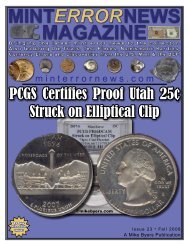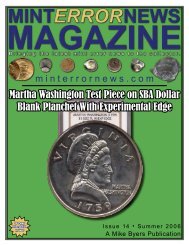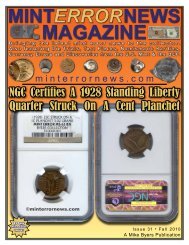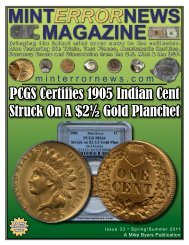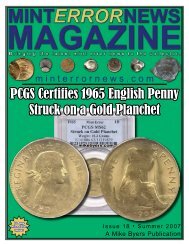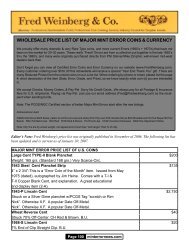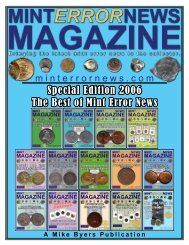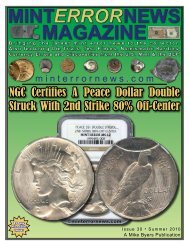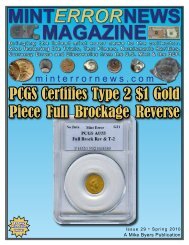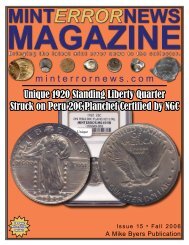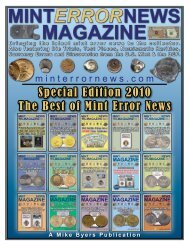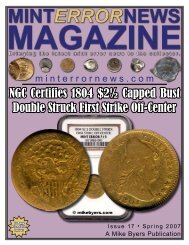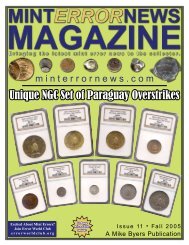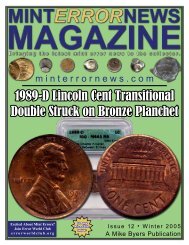You also want an ePaper? Increase the reach of your titles
YUMPU automatically turns print PDFs into web optimized ePapers that Google loves.
J425/P497 Struck Over an 1840-O Quarterby William BierlyReprinted from uspatterns.comNEWLY DISCOVERED OVERDATE QUARTER MAY SHED LIGHT ON “IN GOD WE TRUST” TRANSI-TIONAL PATTERN QUESTION“What year was it really struck?” For the vastmajority of coins this is an irrelevant and perhaps sillyquestion. Just look at the date dummy!! Of course thereare famous exceptions. For example the dollars dated1804 were made decades after 1804, and only painfulresearch has revealed the likely actual years of theirmanufacture.The discovery of an 1865 pattern quarter struckover an 1840-O quarter may shed light on a series ofpattern coins where the actual date of striking haslong been a question. This is the series of Civil Warera coins related to the adoption of the motto “In GodWe Trust”. As for regular issue coins, the motto firstappeared on the 1864 Two Cent piece, and then wasadopted on the regular Quarter, Half Dollar, Dollar,Half Eagle, Eagle, and Double Eagle denominations in1866. However pattern coins with “In God We Trust”actually were struck on 1863 dated Two Cent pieces,1863, 1864, and 1865 dated Quarter, Half, and Dollardenominations, and on 1865 dated Half Eagles, Eagles,and Double Eagles in copper. These coins are called“Transitionals” as they are made/dated in years beforethey were adopted for regular coinage.It was long assumed that all of these “In GodWe Trust” patterns were truly struck in the same yearsthey were dated, but as research evolved, it was generallyconcluded that the 1863 and 1864 dated pieceswere probably struck in later years, perhaps in 1868or 1869 by mint employees for sale to collectors. Diecharacteristics and die rust on the reverses of the 1863and 1864 Quarters tend to reinforce this conclusion.However it was still widely believed that those dated1865 actually were from 1865. In fact the 1949 RedBook even included the 1865 “In God We Trust” HalfDollar as a regular issue.Then in 1977 one of these 1865 transitionals, anPage 261865 “In God We Trust” Dollar (listed as Judd no. 434in one of the standard pattern references, United StatesPattern, Experimental and Trial Pieces by J. HewittJudd) appeared in the Fairfield Collection sale. Thecataloguer, Bowers & Ruddy, noted that the coin wasover struck on an 1866 dollar! The coin was bought byHarry Bass Jr. and today resides in the Bass museumat the ANA in Colorado Springs. The eminent numismaticscholar Walter Breen summarized the impact ofthis discovery in his Complete Encyclopedia of U.S.and Colonial Coins published in 1988:“For generations the silver and gold coins (of1865) were accepted as true transitional issues . . . butin recent years their status has been flung into doubtbecause of a single silver dollar dated 1865 with motto,over struck on another dollar dated 1866.”Breen concluded that all of the 1865 “In GodWe Trust” pattern denominations were likely struck in1866 or later, largely it seems based on the evidence ofthis coin.Fast forward to the late 1990’s when closerinspection of the coin revealed that it was not struckover an 1866 dollar but rather over an 1853! So Breen’sevidence has been nullified and the question of whetherthe 1865 coins are “true transitionals” or later date productionsremains open.All of this background highlights the significanceof the discovery of another of the 1865 patternseries over struck on an earlier coin. In this case it is aQuarter (Judd 425) struck on an 1840-O Quarter. Thecoin, housed in a PCGS Proof 65 holder, was acquiredby the author as an upgrade to another Judd 425 in hiscollection. Upon close examination it was evident thatan 1840-O quarter had been used as the planchet forthe pattern.minterrornews.com



